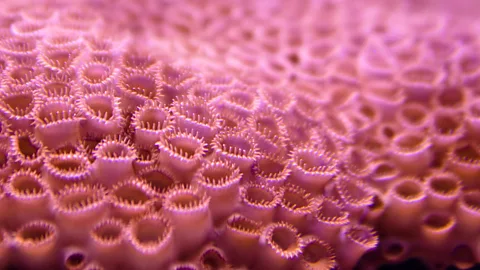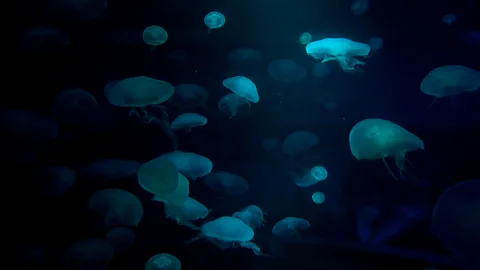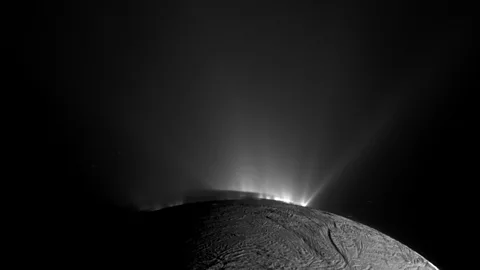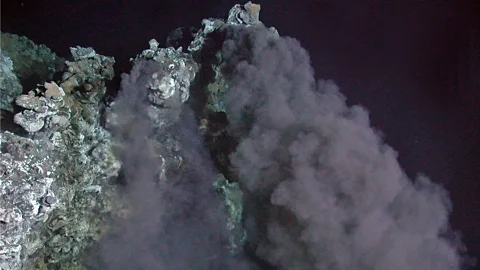What life might be like in alien oceans
 Getty Images
Getty ImagesThe European Space Agency has launched a spacecraft to search for signs that Jupiter’s moons could support life in the oceans beneath their frozen surfaces. If they can, what would organisms look like?
Recent discoveries have led astrobiologists to think that moons are the most promising places for alien life to exist in our Solar System. And now several major space missions are being planned over the next decade to search for hints of life there.
Unlike our neighbouring planets, some of the moons have plenty of liquid water. Jupiter's moon, Europa, for example, is thought to contain more liquid water than all of Earth's oceans combined. This water – and any life in it – is protected from space radiation and asteroid impacts by a thick layer of kilometers-deep surface ice.
A mission to investigate whether Europa has conditions capable of sustaining life is expected to take off on 14 October. Nasa's Clipper mission will take six years to reach the moon, and its findings could radically change our understanding of the Solar System we inhabit.
Searching Jupiter’s icy moons
A mission to investigate whether the icy moons of Jupiter can sustain life has begun its eight-year-long journey.
The European Space Agency's (Esa) Jupiter Icy Moons Explorer, or Juice for short, will visit Callisto, Europa and Ganymede to assess whether they have the right conditions to support life in the oceans beneath their icy surfaces.
It will travel on a circuitous path through the solar system, using the gravitational pull of Venus and the Earth to sling shot it towards Jupiter, where it is expected to arrive in July 2031.
The spacecraft carries 10 different instruments to map the surface of the moons and peer below their frozen crusts. It will make 35 close passes of the moons before settling into an orbit around Ganymede.
The discovery of plumes of water shooting up from Saturn's moon Enceladus and Europa have suggested they could have warm interiors that can support liquid oceans, heated not by the Sun, but by an internal dynamo powered by radioactive decay in their cores or by tidal heating generated by the gravitational attraction of the planets that they orbit.
There is now evidence for water oceans on several moons, including Europa, Enceladus, Callisto and Ganymede. One study published this June estimates that the Enceladus ocean is around one billion years old. Others have suggested it may be billions of years old – plenty of time for life to evolve.
These oceans are thought to be salty, containing sodium chloride, like Earth’s oceans, which is another boost for the prospects of Earth-like life.
Also, there is likely to be an interface between the liquid water and the rocky mantle below the oceans – key ingredients for interesting chemistry that scientists think led to the origins of life on Earth. Nasa's Cassini mission, for example, detected molecules in Enceladus' water plumes that hint at the existence of hydrothermal vents on the moon’s ocean floor.
Similar vents exist in the deep oceans of the Earth, where magma meets salt water and provides heat, chemicals and a substrate helpful for the complex chemistry some scientists think was needed for life to first evolve on our planet. Deep below the surface of Earth's ocean, there is practically no sunlight, as would be the case for oceans of Jupiter and Saturn's moons. But that doesn't mean there is no life. Indeed, on Earth, such vents are teeming with life.
Some 20 years ago Natural History of an Alien, a BBC documentary, suggested that entire ecosystems could also be based around deep-sea thermal vents on Europa. A team of scientists suggested that bacteria would form the base of the food chain, using chemosynthesis to extract energy from the vents, and building tall tubes of deposits rising many miles above the ocean floor.
 Getty Images
Getty ImagesOther creatures, such as fish-like grazers would pierce those tubes to suck in large amounts of bacteria to feed on. They would be territorial, defending their grazing patches against rivals. And, in turn, they would be preyed upon by shark-like animals, streamlined for speed, using echolocation to detect their prey.
This is much more advanced than what most scientists expect to find there.
Even on Earth, for some 90% of our planet's history, the only life that existed here was microbial, says Andrew Knoll, a professor of earth and planetary sciences at Harvard University. So, if there is life in space, chances are it’s going to be microbial, Knoll says, and in places like Europa or Enceladus it would have to rely entirely on chemosynthesis for energy, so could probably only support a small biomass.
 Esa
EsaBut such an ecosystem might still be possible, says Dimitar Sasselov, an astronomy professor and director of the Harvard Origins of Life Initiative, a centre supporting multi-disciplinary research to discover whether life is abundant in the universe. Just because Europa's ocean is cold and lacking in energy, doesn't necessarily rule out complex ecosystems of a smaller size evolving there.
"Speculating is fun," Sasselov says. "My gut feeling is that there is a lot of evolutionary innovation space possible there where you can have something which is small and yet predatory and is a multicellular organism rather than just a single cell."
Another moon we're planning to visit presents a whole different puzzle.
Saturn's moon, Titan, is the only world beyond Earth known to have stable bodies of liquid on its surface. When the Huygens probe from the Cassini mission landed there in 2005, it sent back pictures of an Earth-like landscape: river beds and seas.
But rather than water, the clouds, rain and seas of Titan are made up of liquid methane and ethane, components of natural gas on Earth. Any water that does exist there is solidified into rocks and mountains because its surface temperature is around -180C (-292F).
You might also like:
This means that, while its landscape might look familiar, the actual conditions are totally alien. If there is life, it would rely on methane, not water, and would be exotic – life as we don't know it. True aliens.
It is possible and plausible that life exists on Titan, but with a "completely different, independent biochemistry," says Sasselov, whose long-term goal is to figure out if there is an alternative biochemistry and how to create it in the lab.
 Getty Images
Getty ImagesLife on Earth depends on cell membranes made of phospholipids: molecular chains with phosphorus-oxygen heads and carbon-chain tails that bind to each other to form a flexible membrane in water.
Methane-based life would need an alternative way to form cells.
A Cornell University team led by chemical engineer Paulette Clancy showed in 2015 that small molecules made from nitrogen, carbon and hydrogen could build cells fit to survive in Titan’s conditions.
Since then, Nasa researchers have confirmed the presence of vinyl cyanide in Titan's atmosphere, an organic compound that could provide such cellular membranes. So, at least in theory, cells that could form a very different life in Titan’s vast methane oceans could physically exist there.
"In some respects, what we see here on Earth is a matter of chance," says Theresa Fisher, astrobiologist at Arizona State University, US. There’s an "enormous amount of potential variety" that we could see in life on other worlds, she says.
"There might emerge a fluorescence of new and very diverse organisms occupying a range of new niches," adds Sarah Blaffer Hrdy, a professor emerita in anthropology at the University of California, Davis. "Assuming any of these creatures evolve to be as social, intelligent and communicative as say cetaceans or elephants, and as manipulative, dexterous and clever as chimpanzees or orangutans, I see no reason why they could not eventually evolve more sophisticated technological and cultural capacities."
Lauren Sallan, a palaeontologist at the University of Pennsylvania, thinks alien life will be microbial – and there are only so many ways to be a microbe.
As far as multicellular aliens are concerned, she says, things may get more complicated. "We would recognise that they're doing the same kind of jobs because everything is focused on either taking in energy or consuming things to get energy," she says. "But the way that they go about it would be pretty unpredictable."
 Getty Images
Getty Images"We really don't know what are the limits of life," says David Charbonneau, professor of astronomy at Harvard University, who adds that this is why we need to send more probes to examine the moons.
So, it's good news that there are plans to do just that.
Nasa announced this summer that its Dragonfly mission will launch in 2026 and arrive on Titan in 2034. It will land a drone-like craft to explore dozens of promising locations and look for signs of life.
Nasa is also exploring the possibility of sending an autonomous submarine to study Titan's largest northern sea, Kraken Mare, which is some 1,000 km (621 miles) wide, with depths estimated at 300m (1,000ft), similar in size to North America's Great Lakes. This would be the first opportunity to explore a sea on another world, and it could inform the design of future submarines to explore the subsurface waters of Europa and other moons. The mission is still in its conceptual stage, some 20 years away, with scientists and engineers starting to investigate how to even build such a submarine.
Intriguingly, Titan is also thought to have a liquid ocean of water deep beneath its icy outer layer, which would mean that in addition to its exotic surface life based on liquid methane, there could exist more Earth-like life under its surface.
Another possibility for layers of different types of life on a single world is Ganymede, Jupiter's moon. Some scientists think this moon has several different layers of ocean, separated by different types of ice that form at different depths and pressures. If this is the case, each layer could, in theory, host different lifeforms adapted to local conditions at that depth.
Ganymede is set for a visit by Esa's Juice mission, which launched in April 2023. Due to arrive at Jupiter in 2031, it will also visit two of the giant planet's other moons – Callisto and Europa – to study their habitability and look for signatures of life.
Clipper is due to orbit Jupiter and fly past Europa multiple times to investigate whether it could harbour conditions suitable for life. Nasa is also discussing sending a lander to Europa, which could launch as early as 2025.
 Getty Images
Getty ImagesAnd, there is a private, Nasa-backed plan for a mission to Enceladus to look for life there that could take off in 2025 if it gets the green light later this year.
But to really figure out what life might exist in these alien oceans, we will need to send a submersible, which will be tricky as such a vehicle would have to drill through several kilometres of ice to even reach the ocean. Nasa is funding some conceptual studies on how to do that.
One concept, for a nuclear-powered "tunnelbot" to search for life on Europa, was presented at a 2018 meeting of the American Geophysical Union in Washington DC, by scientists at the University of Illinois at Chicago and Nasa. Their bot would sample ice and water as it descended, sending information back to the surface through a fibre optic cable.
But, if lifeforms there turn out to be truly alien, we might struggle to detect them. It's also possible there simply isn’t any life there yet.
In the distant future, though, some five billion years from now, when our Sun runs out of hydrogen fuel and starts expanding into a red giant phase before it eventually dies, it will melt the ice on these moons and turn them into much more Earth-like places. There should be liquid water on their surface and more temperate climates, perhaps opening up the possibility of life evolving there then – or at least harbouring refugees from the scorched Earth.
In the distant future, if we are to survive, we will all have to become migrants and hope these newly habitable worlds welcome us as our own world gets too hot for life.
* An earlier version of this article was published in September 2019. It has been updated to add detail about Esa's Juice mission.
--
If you liked this story, sign up for The Essential List newsletter – a handpicked selection of features, videos and can't-miss news, delivered to your inbox twice a week.
